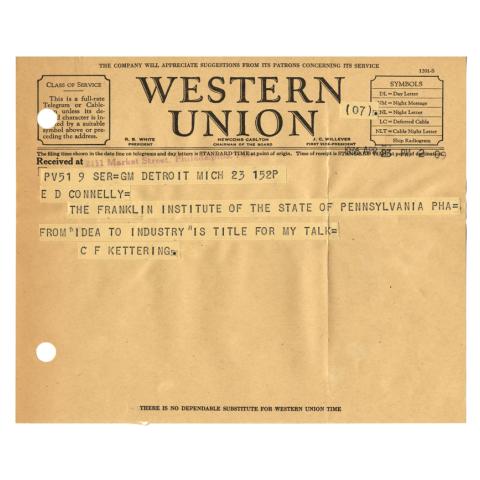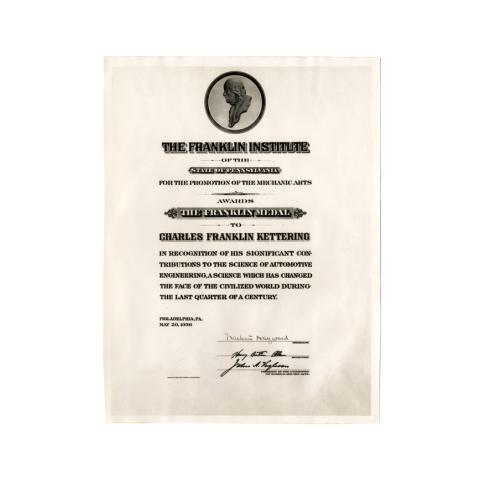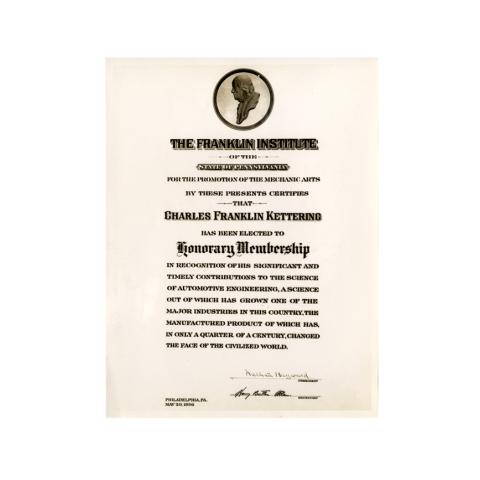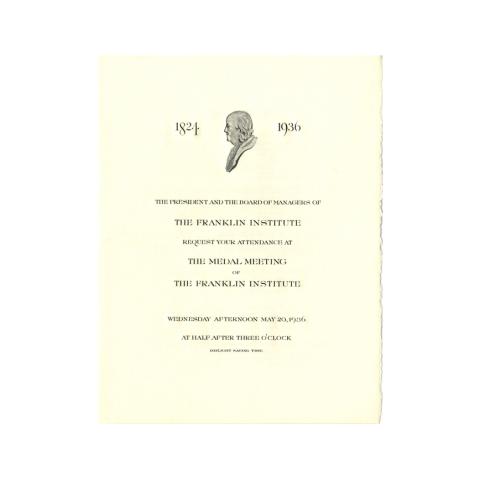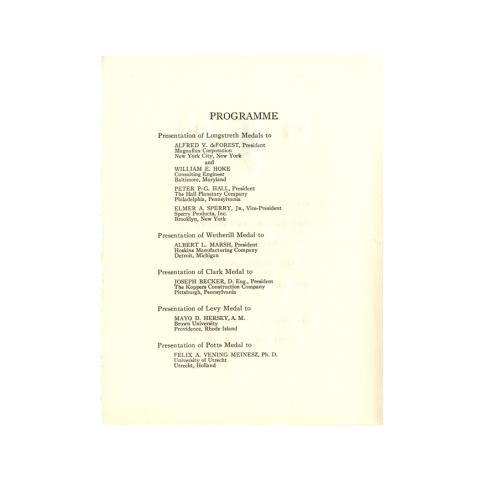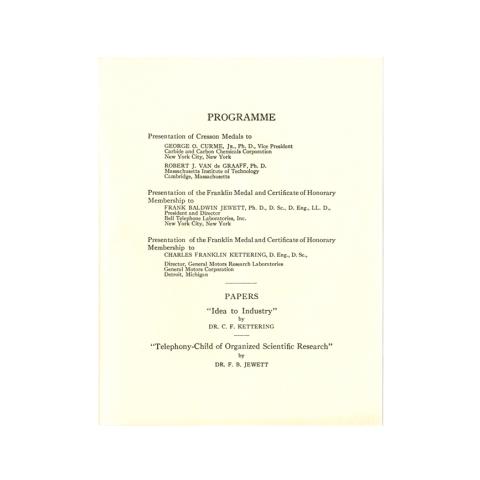Introduction
Charles F. Kettering's interest in the science of automobile engines grew after a colleague asked for help with a car he was building from a kit. With an inclination toward invention and business, Kettering was an influential leader, a lifelong teacher, and an enthusiastic spokesman and promoter of the power of technological progress.
How did Charles Kettering get his start, and what contributions did he make to automotive engineering?
Perseverance
Charles Franklin Kettering was born on a farm near Loudonville, Ohio, on August 29, 1876. He was the fourth of five children of Jacob Kettering and Martha Hunter Kettering. He experienced the strictness of his mother and the farming responsibilities of his father that instilled an interest in mechanical "tinkering." After graduating from high school, Kettering began teaching at a nearby one-room school house. He left two years later to enter the College of Wooster, but due to weak eyesight problems, he returned to teaching. Another two years later Kettering entered Ohio State University, but once again, his eyesight caused him to leave. He began working with a crew installing telephone wiring to carry this recent invention across the countryside. Returning once again to Ohio State, he persevered and eventually, at the age of twenty eight, obtained a degree in electrical engineering. The university recommended him for employment at the National Cash Register Company (NCR) in Dayton, Ohio.
High-Energy Ignition
Hired as an experimental engineer in 1904, Kettering's first task was the motorization of the registers; his team took a year to invent an electric motor applicable to all NCR models. Further work by Kettering's separate teams during the next four years added the basics of accounting machines, low-cost registers, and internal department store communications.
Kettering married Olive Williams of Ashland, Ohio, in 1905, and their only child, Eugene Williams, was born on April 20, 1908.
Kettering's interest in the new science of automobile engines grew when a colleague, Edward Deeds, asked for help with a car he was building himself from a kit. At Deeds' request and with spare-time help from other NCR friends, Kettering developed a high-energy spark ignition system to replace the weak-spark model supplied with the kit. Leaving NCR in 1909, Kettering focused on final development of this ignition set and demonstrations were favorably received. With this response, Kettering and Deeds immediately created the Dayton Engineering Laboratories Company (DELCO).
The development of an electric self-starter replaced the cumbersome—and sometimes dangerous—method of starting the automobile by hand cranking. As the time's most prominent automotive engineer, Kettering focused on applied science and ingenuity rather than theoretical contemplation, and set his research staff to work. Their experimental approach involved a series of reasoned attempts but no stated hypothesis to prove. Delco began converting their prototype to a version which could be mass produced for incorporation in the 1912 Cadillac models.
Bright Idea
During this time Kettering was also occupied with an idea arising from his upbringing and first job—the supply of electricity to rural American areas that the wire supply grid did not reach. The resulting Delco Light Generator revolutionized rural life, providing a powerful light source that extended the day and a motor-driven source of machine power. The generator consisted of lead-acid storage batteries which were charged and recharged from a gasoline engine equipped with an electric starter switch.
Kettering and Deeds sold the flourishing Delco business to General Motors in 1916 and in the same year founded the Dayton-Wright Airplane Company with H. E. Talbott and enlisted Orville Wright as their aeronautical consultant. The company supplied airplanes and engines during World War I and was eventually acquired by General Motors.
Research Efforts
As the automobile industry advanced in Detroit, Alfred P. Sloan of General Motors recruited Kettering two years later to lead the entire company's research efforts. A center, the General Motors Research Corporation, was built in Dayton for this single purpose. Kettering, a prolific inventor, led investigations into all areas of automobile improvement, stressing those which would directly benefit the customer. Advances were made in safety and all automobile processes: brakes, gears, suspension, and lighting. Incidental discoveries such as the coolant Freon, used in refrigeration, also resulted.
Kettering's most widely-used invention was the use of tetraethyl lead as a gasoline additive to solve the problem of engine "knock," a condition of incomplete fuel combustion that causes rapid engine wear. The research team arrived at the lead solution after checking many ingenious approaches and different additive candidates over a period of seven years leading to the 1923 introduction. It remained in use until recognition of its health hazards in the 1960s—after Kettering's death—caused the switchover to lead-free gasoline.
Kettering next turned his attention to diesel engines, inspired by their low fuel consumption and high power potential. Experimenting with diesel power on his own yacht, assisted by his son, Eugene, in the design stage, Kettering saw the outcome of his work when General Motors manufactured the first diesel freight locomotive in 1939.
Leader and Teacher
With his aptitude for invention and business, Kettering became an influential leader and a lifelong teacher. He was an enthusiastic spokesman and promoter of the power of technological progress, pursuing his interests in all modern ideas and methods. At General Motors, he brought a new cooperative-learning approach to the education of employees: in 1926 the General Motors Institute (developed from the Flint YMCA School of Automotive Trades) began training employees with a combination of classroom theory and practical experience in the workplace.
The Kettering Foundation for Medical Research was founded in 1927, and in 1945, Kettering joined Alfred P. Sloan in founding the Sloane-Kettering Institute for cancer treatment. His sister had died from a neck tumor in 1944 and his wife, Olive, died two years later from pancreatic cancer. As befits a member of the Horatio Alger Society, The Kettering Foundation exemplifies its founder's social philosophy on researching the relationship between democracy and the public.
Later on, Kettering suffered a number of strokes yet continued as a consultant to General Motors throughout his life. Charles Kettering (nicknamed "Boss Ket") died on November 25, 1958, in his Dayton, Ohio, home.
Radio Talk
Transcribed from a series of radio talks Charles Kettering gave between September, 1942 and July, 1945.
"Research isn't a physical thing at all but just a state of mind. It is a simple organized way of trying to accomplish something you wish to do—so simple that anyone can do Research anywhere at any time.
First, you select the problem you would like to solve, then you list at least ten reasons why this has not been solved. But in picking that problem be sure to analyze it carefully to see that it is worth the effort. It takes just as much effort to solve a useless problem as a useful one. Make sure the game is worth the candle.
After carefully—and I want to emphasize that word "carefully" selecting the problem and the ten things between you and the solution, you then use the same procedure as in solving a crossword puzzle. You take the easy obstacles first and by a process of elimination you arrive at one or two major ones. In the solution of the remaining obstacles you may need some simple apparatus, but the things you will probably need most are infinite patience and persistence."
"In my opinion, an ounce of experimentation is worth a pound of untried theory."
First Assignment
In 1904, Kettering's first assignment at National Cash Register was to invent a motorized replacement for the hand lever the operator needed to pull for every cash register transaction. His solution was the addition of a small electric motor to the machine. The short, strong bursts of energy the register required were not possible with existing motors so Kettering devised a clutch arrangement to upgrade and exactly match the power needs of the wheel movements in the register.
Electric Starter
The invention by Kettering and Deeds that led to the founding of their Dayton Engineering Laboratories Company (DELCO) plant bore similarities in principle to the cash register motor in that it provided a short, intense spurt of electricity. Since this device improved operation of the automobile, its success was assured and permanent.
Gasoline engines require the pistons to be moving before ignition takes place and so an outside agent must be used to set them in motion. Once in motion the engine's own power takes over the ignition process.
Up to that time, automobiles were started by hand cranking: a process requiring strength and reflexes. The strength was needed to turn the hand crank connected to the large flywheel and so move the crankshaft and set the engine parts in motion. Quick reflexes were necessary for the operator to step aside immediately once the engine started and avoid the dangerous and powerful "kick back" on the turning handle when the engine started and threw off the need for the crank. Henry Leland, head of the Cadillac Motor Co., had lost a friend who was injured and later died from such a "kick back." As soon as it was available, he included the new electric starter in all Cadillac models.
Kettering and Deeds recognized that the electric starter needed high initial energy to turn the flywheel and start the engine's pistons moving. Once the pistons began to move, ignition would take place in the cylinders and the engine would take over running. Their starter used the existing, low current from the car's battery, stepped it up, and created the high current and motor power which turned the flywheel and exploded the gas in the engine cylinder. Once the piston cycle was started, a relay disconnected the starter motor and the engine operated the vehicle and the battery recharging, plus other low current needs such as lighting. The electric starter was the subject of United States Patent No. 1,150,523, issued to Charles Kettering and Clyde Coleman.
Engine Knock
Automobile engine "knock" is a hammering or pinging sound associated with unusual engine vibration and consequently increased engine wear. It is caused by uncontrolled ignition of the compressed gasoline/air mixture in the engine's pistons. The irregular stresses built up harm the piston and cylinder materials and result in the knocking sound and engine wear.
Following their systematic research protocol of first defining the problem, Kettering and Thomas Midgley, Jr. used a monograph to inspect the action of pistons in their test engine and found that the knock was not caused by premature ignition from the self-starter battery arrangement but by pressure increase after spark plug ignition. Their next step was to pose a series of possible theories and go about testing each one. They decided that the solution lay in using a gasoline additive so a variety were proposed and tried and their results evaluated.
The first experiment tested the theory that red-colored material might absorb heat and correct the cylinder conditions. Iodine, being red, was tried successfully but a follow-up with red aniline dyes failed, disproving the "red coloring" theory. Next, colorless ethyl iodide proved effective and their chemical research continued. The team was diverted to work on aircraft fuels during World War I and tested a wide range of chemicals for aviation applications: ethanol, petroleum aromatics such as benzene, petroleum olefins, ethers, and paraffins. Their final decision recommended a mixture of benzene and gasoline but the war's end cancelled production plans and the researchers returned to civilian pursuits. Again iodine was the best anti-knock candidate but it was corrosive and expensive. Enthusiasm waned and research bogged down until Kettering happened on an article about the effectiveness of selenium as an additive; Midgley was re-energized. His new approach was to create a list of elements as candidates and systematically check the effectiveness of each in his one-cylinder laboratory test engine. The list included tellurium, arsenic, silver, silicon, germanium, lead, and tin.
In December, 1921, after seven years of research, it was found that very small amounts of lead, dissolved in ethanol and added to gasoline, removed the engine knock completely. Engine power and efficiency increased and tetraethyl lead became the leading gasoline additive for many years to follow, until realization of the dangers of atmospheric lead came about.
Other Developments
Kettering had invented the Delco Light Generator which revolutionized rural life by extending the hours of light available for work and recreation. Simply moving the electric switch for the gasoline engine caused the batteries to fully charge and recharge. In 1918, a three kilowatt light plant could be powered by a one-cylinder 5-horsepower engine.
Another material developed by Midgley and Kettering with enormous implications was Freon, a group of halocarbon compounds that replaced the toxic ammonia and sulfur dioxide as refrigerant. Refrigerator compressors working from chemicals that were non-flammable, non-toxic, and chemically inert gained wide acceptance and their use expanded the scope of food storage and, via air conditioning, extended the comfort and usable hours of workers.
U.S. Patent No. 1,886,339 for dichlorodifluoromethane, the first Freon, was issued to Frigidaire, the General Motors Division headed by Kettering, on December 31, 1928. Dupont Company undertook the commercial manufacture of Freons and the line grew to over twenty different products differentiated by the length of the aliphatic carbon chain and the degree of chlorine and fluorine substitution. Their applications widened to aerosol propellants and inhalers. Freon use was phased out as it was discovered in the 1970s that the compounds deplete the earth's protective ozone layer
Acknowledgement
Charles F. Kettering was a holder or co-holder of more than 300 patents. Their wide-ranging topics include: the motorization of the cash register, the electric auto starter, portable lighting generator, leaded gasoline, Freon refrigerant, automobile paint, an incubator for premature babies, and a treatment for venereal disease.
He received many honorary doctorates and degrees plus dozens of other citations and medals.
His name is memorialized in the Charles F. Kettering Foundation for medical research, the Sloan-Kettering Institute for Cancer Research, the Charles F. Kettering Memorial Hospital, and Kettering University.
The annual Charles F. Kettering Prize, created by the General Motors Cancer Research Foundation, honors the most outstanding recent contribution to the diagnosis or treatment of cancer.
Charles F. Kettering was awarded the 1936 Franklin Medal by The Franklin Institute for the science of automotive engineering.
Credits
The Charles F. Kettering presentation is made possible by support from The Barra Foundation and Unisys.
This website is the effort of an in-house special project team at The Franklin Institute, working under the direction of Carol Parssinen, Senior Vice-President for the Center for Innovation in Science Learning, and Bo Hammer, Vice-President for The Franklin Center.
Special project team members from the Educational Technology department are:
Karen Elinich, Barbara Holberg, Margaret Ennis, and Zach Williams.
Special project team members from the Curatorial department are:
John Alviti.
The project's Advisory Board Members are:
Ruth Schwartz-Cowan, Leonard Rosenfeld, Nathan Ensmenger, and Susan Yoon.
Read the Committee on Science and the Arts Report on Charles F Kettering’s life and his advancements of the automobile.



